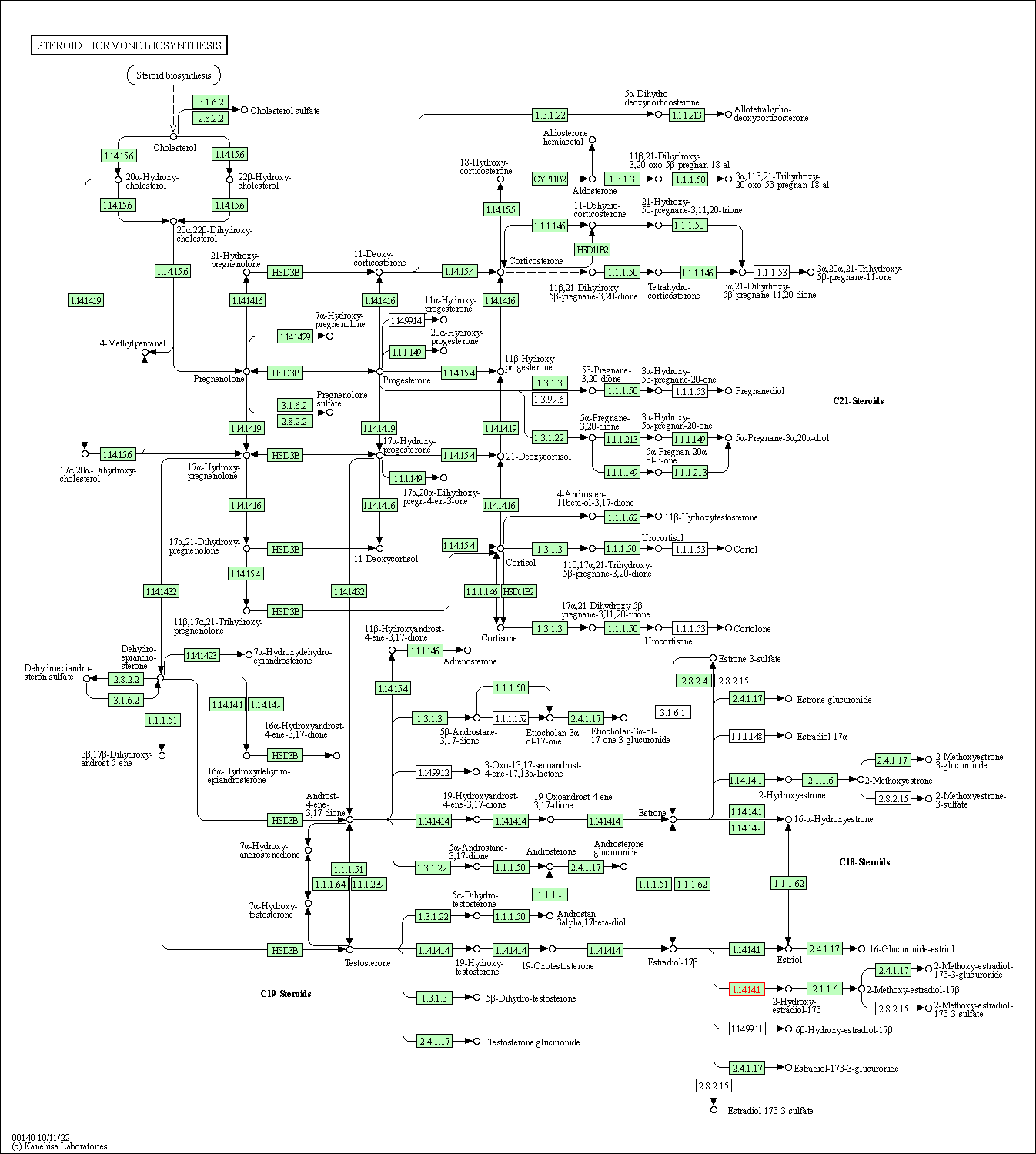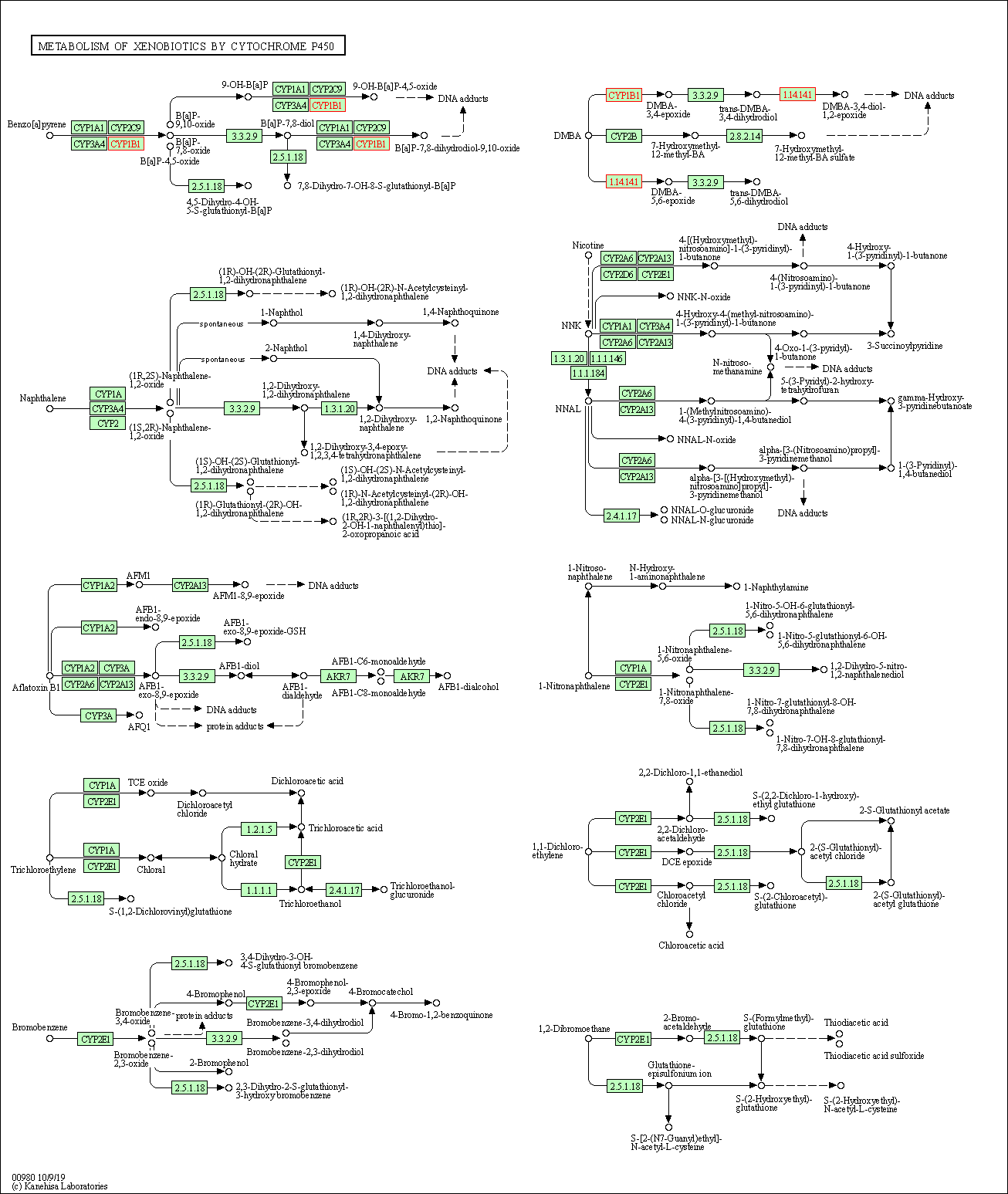Target Information
| Target General Information | Top | |||||
|---|---|---|---|---|---|---|
| Target ID |
T92521
(Former ID: TTDR00242)
|
|||||
| Target Name |
Cytochrome P450 1B1 (CYP1B1)
|
|||||
| Synonyms |
CYPIB1
Click to Show/Hide
|
|||||
| Gene Name |
CYP1B1
|
|||||
| Target Type |
Clinical trial target
|
[1] | ||||
| Function |
In liver microsomes, this enzyme is involved in an NADPH-dependent electron transport pathway. It oxidizes a variety of structurally unrelated compounds, including steroids, fatty acids, retinoid and xenobiotics. Preferentially oxidizes 17beta-estradiol to the carcinogenic 4-hydroxy derivative, and a variety of procarcinogenic compounds to their activated forms, including polycyclic aromatic hydrocarbons. Promotes angiogenesis by removing cellular oxygenation products, thereby decreasing oxidative stress, release of antiangiogenic factor THBS2, then allowing endothelial cells migration, cell adhesion and capillary morphogenesis. These changes are concommitant with the endothelial nitric oxide synthase activity and nitric oxide synthesis. Plays an important role in the regulation of perivascular cell proliferation, migration, and survival through modulation of the intracellular oxidative state and NF-kappa-B expression and/or activity, during angiogenesis. Contributes to oxidative homeostasis and ultrastructural organization and function of trabecular meshwork tissue through modulation of POSTN expression. Cytochromes P450 are a group of heme-thiolate monooxygenases.
Click to Show/Hide
|
|||||
| BioChemical Class |
Paired donor oxygen oxidoreductase
|
|||||
| UniProt ID | ||||||
| EC Number |
EC 1.14.14.-
|
|||||
| Sequence |
MGTSLSPNDPWPLNPLSIQQTTLLLLLSVLATVHVGQRLLRQRRRQLRSAPPGPFAWPLI
GNAAAVGQAAHLSFARLARRYGDVFQIRLGSCPIVVLNGERAIHQALVQQGSAFADRPAF ASFRVVSGGRSMAFGHYSEHWKVQRRAAHSMMRNFFTRQPRSRQVLEGHVLSEARELVAL LVRGSADGAFLDPRPLTVVAVANVMSAVCFGCRYSHDDPEFRELLSHNEEFGRTVGAGSL VDVMPWLQYFPNPVRTVFREFEQLNRNFSNFILDKFLRHCESLRPGAAPRDMMDAFILSA EKKAAGDSHGGGARLDLENVPATITDIFGASQDTLSTALQWLLLLFTRYPDVQTRVQAEL DQVVGRDRLPCMGDQPNLPYVLAFLYEAMRFSSFVPVTIPHATTANTSVLGYHIPKDTVV FVNQWSVNHDPLKWPNPENFDPARFLDKDGLINKDLTSRVMIFSVGKRRCIGEELSKMQL FLFISILAHQCDFRANPNEPAKMNFSYGLTIKPKSFKVNVTLRESMELLDSAVQNLQAKE TCQ Click to Show/Hide
|
|||||
| 3D Structure | Click to Show 3D Structure of This Target | PDB | ||||
| HIT2.0 ID | T69XVX | |||||
| Cell-based Target Expression Variations | Top | |||||
|---|---|---|---|---|---|---|
| Cell-based Target Expression Variations | ||||||
| Drug Binding Sites of Target | Top | |||||
|---|---|---|---|---|---|---|
| Ligand Name: Alpha-naphthoflavone | Ligand Info | |||||
| Structure Description | Structural Characterization of the Complex between Alpha-Naphthoflavone and Human Cytochrome P450 1B1 (CYP1B1) | PDB:3PM0 | ||||
| Method | X-ray diffraction | Resolution | 2.70 Å | Mutation | No | [3] |
| PDB Sequence |
QAAHLSFARL
77 ARRYGDVFQI87 RLGSCPIVVL97 NGERAIHQAL107 VQQGSAFADR117 PSFASFRVVS 127 GGRSMAFGHY137 SEHWKVQRRA147 AHSMMRNFFT157 RQPRSRQVLE167 GHVLSEAREL 177 VALLVRGSAD187 GAFLDPRPLT197 VVAVANVMSA207 VCFGCRYSHD217 DPEFRELLSH 227 NEEFGRTVGA237 GSLVDVMPWL247 QYFPNPVRTV257 FREFEQLNRN267 FSNFILDKFL 277 RHCESLRPGA287 APRDMMDAFI297 LSAEKKAAGD307 GARLDLENVP321 ATITDIFGAS 331 QDTLSTALQW341 LLLLFTRYPD351 VQTRVQAELD361 QVVGRDRLPC371 MGDQPNLPYV 381 LAFLYEAMRF391 SSFVPVTIPH401 ATTANTSVLG411 YHIPKDTVVF421 VNQWSVNHDP 431 LKWPNPENFD441 PARFLDKDGL451 INKDLTSRVM461 IFSVGKRRCI471 GEELSKMQLF 481 LFISILAHQC491 DFRANPNEPA501 KMNFSYGLTI511 KPKSFKVNVT521 LRESMELLD |
|||||
|
|
VAL126
4.113
SER127
4.678
SER131
4.759
ALA133
4.560
PHE134
3.530
HIS227
4.898
ASN228
3.525
PHE231
3.302
LEU264
3.679
ASN265
4.245
PHE268
3.797
|
|||||
| Ligand Name: 2-(cis-4-azidocyclohexyl)-4H-naphtho[1,2-b]pyran-4-one | Ligand Info | |||||
| Structure Description | Crystal Structure of CYP1B1 and Inhibitor Having Azide Group | PDB:6IQ5 | ||||
| Method | X-ray diffraction | Resolution | 3.70 Å | Mutation | Yes | [4] |
| PDB Sequence |
QAAHLSFARL
77 ARRYGDVFQI87 RLGSCPIVVL97 NGERAIHQAL107 VQQGSAFADR117 PSFASFRVVS 127 GGRSMAFGHY137 SEHWKVQRRA147 AHSMMRNFFT157 RQPRSRQVLE167 GHVLSEAREL 177 VALLVRGSAD187 GAFLDPRPLT197 VVAVANVMSA207 VCFGCRYSHD217 DPEFRELLSH 227 NEEFGRTVGA237 GSLVDVMPWL247 QYFPNPVRTV257 FREFEQLNRN267 FSNFILDKFL 277 RHCESLRPGA287 APRDMMDAFI297 LSAEKKAAGD307 GARLDLENVP321 ATITDIFGAS 331 QDTLSTALQW341 LLLLFTRYPD351 VQTRVQAELD361 QVVGRDRLPC371 MGDQPNLPYV 381 LAFLYEAMRF391 SSFVPVTIPH401 ATTANTSVLG411 YHIPKDTVVF421 VNQWSVNHDP 431 VKWPNPENFD441 PARFLDKDGL451 INKDLTSRVM461 IFSVGKRRCI471 GEELSKMQLF 481 LFISILAHQC491 DFRANPNEPA501 KMNFSYGLTI511 KPKSFKVNVT521 LRESMELLD |
|||||
|
|
VAL126
3.585
SER127
3.799
SER131
3.890
ALA133
3.948
PHE134
3.772
ASN228
3.538
PHE231
3.354
LEU264
3.100
ASN265
3.849
PHE268
3.314
THR325
4.068
|
|||||
| Click to View More Binding Site Information of This Target with Different Ligands | ||||||
| Different Human System Profiles of Target | Top |
|---|---|
|
Human Similarity Proteins
of target is determined by comparing the sequence similarity of all human proteins with the target based on BLAST. The similarity proteins for a target are defined as the proteins with E-value < 0.005 and outside the protein families of the target.
A target that has fewer human similarity proteins outside its family is commonly regarded to possess a greater capacity to avoid undesired interactions and thus increase the possibility of finding successful drugs
(Brief Bioinform, 21: 649-662, 2020).
Human Tissue Distribution
of target is determined from a proteomics study that quantified more than 12,000 genes across 32 normal human tissues. Tissue Specificity (TS) score was used to define the enrichment of target across tissues.
The distribution of targets among different tissues or organs need to be taken into consideration when assessing the target druggability, as it is generally accepted that the wider the target distribution, the greater the concern over potential adverse effects
(Nat Rev Drug Discov, 20: 64-81, 2021).
Human Pathway Affiliation
of target is determined by the life-essential pathways provided on KEGG database. The target-affiliated pathways were defined based on the following two criteria (a) the pathways of the studied target should be life-essential for both healthy individuals and patients, and (b) the studied target should occupy an upstream position in the pathways and therefore had the ability to regulate biological function.
Targets involved in a fewer pathways have greater likelihood to be successfully developed, while those associated with more human pathways increase the chance of undesirable interferences with other human processes
(Pharmacol Rev, 58: 259-279, 2006).
Biological Network Descriptors
of target is determined based on a human protein-protein interactions (PPI) network consisting of 9,309 proteins and 52,713 PPIs, which were with a high confidence score of ≥ 0.95 collected from STRING database.
The network properties of targets based on protein-protein interactions (PPIs) have been widely adopted for the assessment of target’s druggability. Proteins with high node degree tend to have a high impact on network function through multiple interactions, while proteins with high betweenness centrality are regarded to be central for communication in interaction networks and regulate the flow of signaling information
(Front Pharmacol, 9, 1245, 2018;
Curr Opin Struct Biol. 44:134-142, 2017).
Human Similarity Proteins
Human Tissue Distribution
Human Pathway Affiliation
Biological Network Descriptors
|
|
|
There is no similarity protein (E value < 0.005) for this target
|
|
Note:
If a protein has TS (tissue specficity) scores at least in one tissue >= 2.5, this protein is called tissue-enriched (including tissue-enriched-but-not-specific and tissue-specific). In the plots, the vertical lines are at thresholds 2.5 and 4.
|




| KEGG Pathway | Pathway ID | Affiliated Target | Pathway Map |
|---|---|---|---|
| Steroid hormone biosynthesis | hsa00140 | Affiliated Target |

|
| Class: Metabolism => Lipid metabolism | Pathway Hierarchy | ||
| Tryptophan metabolism | hsa00380 | Affiliated Target |

|
| Class: Metabolism => Amino acid metabolism | Pathway Hierarchy | ||
| Metabolism of xenobiotics by cytochrome P450 | hsa00980 | Affiliated Target |

|
| Class: Metabolism => Xenobiotics biodegradation and metabolism | Pathway Hierarchy | ||
| Ovarian steroidogenesis | hsa04913 | Affiliated Target |

|
| Class: Organismal Systems => Endocrine system | Pathway Hierarchy | ||
| Degree | 4 | Degree centrality | 4.30E-04 | Betweenness centrality | 1.86E-05 |
|---|---|---|---|---|---|
| Closeness centrality | 1.54E-01 | Radiality | 1.21E+01 | Clustering coefficient | 0.00E+00 |
| Neighborhood connectivity | 7.00E+00 | Topological coefficient | 3.16E-01 | Eccentricity | 12 |
| Download | Click to Download the Full PPI Network of This Target | ||||
| Chemical Structure based Activity Landscape of Target | Top |
|---|---|
| Drug Property Profile of Target | Top | |
|---|---|---|
| (1) Molecular Weight (mw) based Drug Clustering | (2) Octanol/Water Partition Coefficient (xlogp) based Drug Clustering | |
|
|
||
| (3) Hydrogen Bond Donor Count (hbonddonor) based Drug Clustering | (4) Hydrogen Bond Acceptor Count (hbondacc) based Drug Clustering | |
|
|
||
| (5) Rotatable Bond Count (rotbonds) based Drug Clustering | (6) Topological Polar Surface Area (polararea) based Drug Clustering | |
|
|
||
| "RO5" indicates the cutoff set by lipinski's rule of five; "D123AB" colored in GREEN denotes the no violation of any cutoff in lipinski's rule of five; "D123AB" colored in PURPLE refers to the violation of only one cutoff in lipinski's rule of five; "D123AB" colored in BLACK represents the violation of more than one cutoffs in lipinski's rule of five | ||
| Co-Targets | Top | |||||
|---|---|---|---|---|---|---|
| Co-Targets | ||||||
| Target Poor or Non Binders | Top | |||||
|---|---|---|---|---|---|---|
| Target Poor or Non Binders | ||||||
| Target Regulators | Top | |||||
|---|---|---|---|---|---|---|
| Target-regulating microRNAs | ||||||
| Target-Related Models and Studies | Top | |||||
|---|---|---|---|---|---|---|
| Target Validation | ||||||
| References | Top | |||||
|---|---|---|---|---|---|---|
| REF 1 | Selective inhibition of methoxyflavonoids on human CYP1B1 activity. Bioorg Med Chem. 2010 Sep 1;18(17):6310-5. | |||||
| REF 2 | Design, synthesis, and discovery of novel trans-stilbene analogues as potent and selective human cytochrome P450 1B1 inhibitors. J Med Chem. 2002 Jan 3;45(1):160-4. | |||||
| REF 3 | Structural characterization of the complex between alpha-naphthoflavone and human cytochrome P450 1B1. J Biol Chem. 2011 Feb 18;286(7):5736-43. | |||||
| REF 4 | Design and synthesis of selective CYP1B1 inhibitor via dearomatization of Alpha-naphthoflavone. Bioorg Med Chem. 2019 Jan 15;27(2):285-304. | |||||
If You Find Any Error in Data or Bug in Web Service, Please Kindly Report It to Dr. Zhou and Dr. Zhang.

